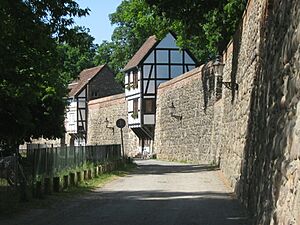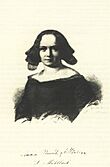Neubrandenburg facts for kids
Quick facts for kids
Neubrandenburg
|
|||
|---|---|---|---|

Neubrandenburg skyline with Tollensesee
|
|||
|
|||
| Country | Germany | ||
| State | Mecklenburg-Vorpommern | ||
| District | Mecklenburgische Seenplatte | ||
| Subdivisions | 10 Stadtteile | ||
| Area | |||
| • Total | 85.65 km2 (33.07 sq mi) | ||
| Elevation | 20 m (70 ft) | ||
| Population
(2022-12-31)
|
|||
| • Total | 63,989 | ||
| • Density | 747.10/km2 (1,934.98/sq mi) | ||
| Time zone | UTC+01:00 (CET) | ||
| • Summer (DST) | UTC+02:00 (CEST) | ||
| Postal codes |
17033, 17034, 17036, 17050
|
||
| Dialling codes | 0395 | ||
| Vehicle registration | NB | ||
| Website | www.neubrandenburg.de | ||
Neubrandenburg is a city in the southeast of Mecklenburg-Vorpommern, Germany. Its name means New Brandenburg. The city is located on the shore of a beautiful lake called Tollensesee. It is a main town in the Mecklenburg Lakeland area.
Neubrandenburg is well-known for its amazing medieval buildings made of Brick Gothic style. This includes one of the best-preserved defensive walls in the world. It also has a special Concert Church (Saint Mary), where the Neubrandenburg Philharmonic orchestra plays. The city is part of the European Route of Brick Gothic, which connects important brick buildings across seven countries near the Baltic Sea. People often call Neubrandenburg the "City of Four Gates" because of its four old city gates.
Since 2011, Neubrandenburg has been the capital of the Mecklenburgische Seenplatte district. It is the third-largest city in Mecklenburg-Vorpommern. The city is an important economic hub in northeastern Germany. It has many jobs and a strong economy. Nearby big cities include Rostock, Szczecin, Berlin, and Hamburg. Since 1991, Neubrandenburg has been home to a University of Applied Sciences. This university offers programs for students from all over the world.
Contents
History of Neubrandenburg
The first Christian monks came to this area around 1240. They built a monastery called Broda Abbey near the lake. The city of Neubrandenburg was officially started in 1248. The Margrave of Brandenburg decided to build a new town in the northern part of his land. He named it after the older city of Brandenburg. In 1292, Neubrandenburg and the land around it became part of Mecklenburg.
The city grew and became an important trading center. However, this changed during the Thirty Years' War (1618–48). The war caused a lot of damage and loss. During this time, the city was occupied by Swedish soldiers. Later, other forces took it back. The city faced many challenges during this difficult period.
In Second World War, Neubrandenburg had prisoner-of-war camps for Allied soldiers. There was also a camp for forced labor. In 1945, near the end of the war, a large fire destroyed about 80% of the old town. Since then, many of the important historical buildings have been rebuilt. After the war, from 1945 to 1948, a special camp was run at the site of one of the former prisoner camps.
Neubrandenburg was an important regional center from 1952 to 1990.
What to See in Neubrandenburg
Neubrandenburg has kept its entire medieval city wall. The wall is 7 meters high and about 2.3 kilometers long. It has four amazing Brick Gothic city gates, built in the 14th and 15th centuries. One of the most impressive gates is the Stargarder Tor. It has a unique gable shape and beautiful decorations.
Another interesting place is the Brick Gothic Marienkirche, also known as St. Mary's Church. It was finished in 1298. The church was almost destroyed in 1945. But it was rebuilt and opened as a concert hall in 2001. It is now called the Konzertkirche (Concert Church).
The tallest building in the city is the 56-meter-tall Haus der Kultur und Bildung (HKB). This building, opened in 1965, is nicknamed Kulturfinger ("culture finger") because of its slender shape. You can also visit the Neubrandenburg Regional Museum.
Education in Neubrandenburg
- Hochschule Neubrandenburg (University of Applied Sciences)
- Three large secondary schools for older students
Sports in Neubrandenburg
Neubrandenburg is known as a "city of sports" (Sportstadt). Many Olympic medal winners and talented athletes come from here. They are especially good in sports like canoeing, discus throwing, shotput, and running. For example, Andreas Dittmer and Martin Hollstein are famous canoeists. Astrid Kumbernuss, Ralf Bartels, and Franka Dietzsch are well-known for discus and shotput.
The city has excellent sports facilities. These include the Jahnstadion, the Jahnsportforum stadium, and the Stadthalle. These places host many large sports and cultural events. Neubrandenburg also has a special sports school called the Sportgymnasium Neubrandenburg. This school helps young athletes develop their skills.
The Günter Harder Stadion was a stadium that existed from 1949 to about 1996. It was used for football and motorcycle speedway races. It even hosted qualifying rounds for the Speedway World Championship in 1964 and 1965.
Notable People from Neubrandenburg
Neubrandenburg has been home to many interesting people, including:
- Wenceslaus Johann Gustav Karsten (1732–1787), a German mathematician.
- Luise Mühlbach (1814-1873), a German writer who wrote historical stories.
- Theodor Leipart (1867–1947), a German trade union leader.
- Theodor Estermann (1902–1991), an American mathematician.
- Jürnjakob Timm (born 1949), a German cellist who played in a famous orchestra for over 40 years.
- Annegret Rosenmüller (born 1967), a German music expert.
Sports Stars from Neubrandenburg
Many famous athletes have come from Neubrandenburg:
- Hans-Jürgen Wallbrecht (1943–1970), a German rower who won a silver medal at the 1964 Olympics.
- Rüdiger Helm (born 1956), an East German sprint canoeist who won many Olympic gold and bronze medals.
- Ulf Hielscher (born 1967), a German bobsledder who won a bronze medal at the 1994 Winter Olympics.
- Jana Sorgers (born 1967), a German rower who won a gold medal at the 1988 Olympics.
- Tim Borowski (born 1980), a football manager and former player. He played many games for Germany.
- Sebastian Zbik (born 1982), a German boxer who was a world champion.
- Viola Odebrecht (born 1983), a former female footballer who played many games for Germany.
- Martin Hollstein (born 1987), a German sprint canoeist who won Olympic gold and bronze medals.
Sister Cities
Neubrandenburg is connected with other cities around the world. These are called "sister cities" or "twin towns." They work together to share culture and ideas.
Images for kids
See also
 In Spanish: Nuevo Brandeburgo para niños
In Spanish: Nuevo Brandeburgo para niños
















